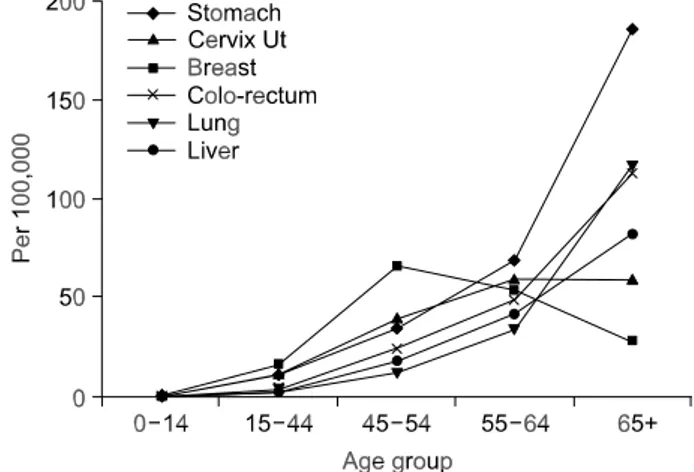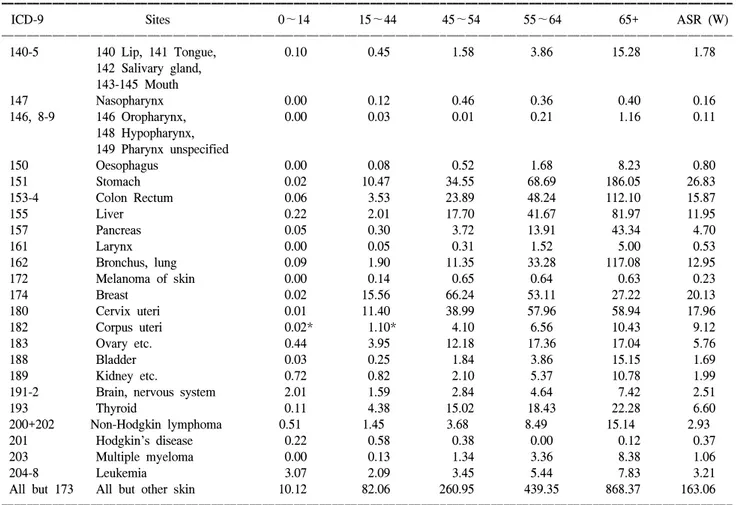Cancer Research and Treatment 2002;34(6):405-408
405 INTRODUCTION
The information on the occurrence of cancer, and the risk of different cancers, are very important for the study of cancer. Since the establishment of Korea Central Cancer Registry (KCCR) Program in 1980, many efforts to present data on the incidence of cancers from reliable registries have been made in Korea (1). Population-based cancer registries provide valid estimates on the incidences of cancer in defined populations. There are four frontiers in terms of population-based cancer registry in Korea; the Kangwha, the Seoul, the Busan and the Daegu Cancer Registries, in that chronological order of establishment.
In this paper, we describe an estimation of the incidence of cancers in Korea using national mortality data and incidence data from the four frontier regional cancer reg-istries, which will appear in the Cancer Incidence in Five Continents Vol. VIII (2).
MATERIALS AND METHODS
Using national mortality data (3) and data from the four regional cancer registries, we assumed that the logarithm of the incidence rate of a given cancer can be expressed as a linear function of the logarithm of mortality in each sex-age group. Separate models were fitted for 25 cancers, using the incidence and mortality data provided by the four cancer registries, and parameter estimators were applied to the national mortality data (source: World Health Organization, period 1998∼2000), in order to provide national incidence rates. Seven age groupings were used for the purpose of developing the model: 0-44, 45∼ 49, ..., 70∼75+. The estimated number of cancer cases in the age group 0-44 was then split into 0-14 and 15-44 using proportions given by the cancer registries.
RESULTS
The overall age-standardized incidence rates (ASR), ex-cluding other malignant neoplasm of the skin, were 287.0 and 163.1 per 100,000 for males and females, respectively (Table 1, 2). Among males, stomach cancer was the most frequent (ASR 69.6), followed by lung cancers, including bronchus cancer (ASR 54.5), liver cancer (ASR 47.0) and colo-rectal cancer (ASR 25.2). The most frequent sites of cancer in females, by rank order, were stomach (ASR 26.8), breast (ASR 20.1), uterine cervix (ASR 18.0), colo-rectum (ASR 15.9), lung
Cancer Incidence in Korea
Hai-Rim Shin*, M.D.
1,2, Yoon-Ok Ahn*, M.D.
3, Jong-Myon Bae, M.D.
1, Myung-Hee Shin, M.D.
3, Duk-Hee
Lee, M.D.
2, Choong-Won Lee, M.D.
4, Heechoul Ohrr, M.D.
5, Don-Hee Ahn, M.D.
6, Jacques Ferlay
7,
Dornald Maxwell Parkin, M.D.
7, Dae-Kyu Oh, M.D.
8and Jae-Gahb Park, M.D.
11
Headquarter of Korea Central Cancer Registry, National Cancer Center,
2Busan Cancer Registry,
3Seoul Cancer Registry,
4Daegu Cancer Registry,
5Kangwha County Cancer Registry,
6National Medical Center,
7International Agency for Research
on Cancer, France,
8Bureau of Health Promotion, Ministry of Health & Welfare, Korea
Purpose: W e estim ated the incidence of cancer in Korea.
Materials and Methods: The indicence of cancer was estimated using national mortality data, and the incidence data from four frontier regional cancer registries, including Kangwha, Seoul, Busan and Deagu. These four registries served a population about seventeen m illion, which is almost 38% of entire population in Korea. Results: The overall age-standardized incidence rates (ASR) were 287.0 and 163.1 per 100,000 for m ales and females, respectively. Among males, stomach cancer was the m ost frequent (ASR 69.6), followed by lung cancers,
including bronchus cancer (ASR 54.5), liver cancer (ASR 47.0) and colo-rectal cancer (ASR 25.2). The most frequent sites of cancer in fem ales, by rank order, were stom ach (ASR 26.8), breast (ASR 20.1), uterine cervix (ASR 18.0), colo-rectum (ASR 15.9), lung (ASR 13.0) and liver (ASR 12.0).
Conclusion: It is hoped that these results will provide valuable leads for cancer research and cancer control in Korea. (Cancer Research and Treatm ent 2002;34:405-408)
ꠏꠏꠏꠏꠏꠏꠏꠏꠏꠏꠏꠏꠏꠏꠏꠏꠏꠏꠏꠏꠏꠏꠏꠏꠏꠏꠏꠏꠏꠏꠏꠏꠏꠏꠏꠏꠏꠏꠏꠏꠏꠏꠏꠏꠏꠏꠏꠏꠏꠏꠏꠏꠏꠏꠏ Key W ords: Cancer, Incidence, Registry
*Equivalent co-first authors
Correspondence: Jae-Gahb Park, National Cancer Center, 809 Madu1-dong, Ilsan-gu, Goyang-si, Gyeonggi-do 411-764, Korea, (Tel) 82-31-920-1501, (Fax) 82-31-920-1511 (E-mail) park@ncc.re.kr
Received December 16, 2002, Accepted December 23, 2002 This work was supported by Research Grant N01E020 from the National Cancer Center, Korea
406 Cancer Research and Treatment 2002;34(6)
(ASR 13.0) and liver (ASR 12.0).
The age-specific incidence rates for the leading cancer sites in males and females are shown in Fig. 1 and 2, respectively. The overall rate of stomach cancer was highest, however, liver cancer in the 45∼54 age group among males was highest. Unlike other cancers, the incidence of breast cancer reached a maximum in females aged 45∼54, which
de-creased thereafter.
DISCUSSION
Our presented results are the first estimation on the incidence of cancer in Korea. About 80% of the cases are from the
Table 1. Age standardized cancer incidence by age group among males in Korea
ꠚꠚꠚꠚꠚꠚꠚꠚꠚꠚꠚꠚꠚꠚꠚꠚꠚꠚꠚꠚꠚꠚꠚꠚꠚꠚꠚꠚꠚꠚꠚꠚꠚꠚꠚꠚꠚꠚꠚꠚꠚꠚꠚꠚꠚꠚꠚꠚꠚꠚꠚꠚꠚꠚꠚꠚꠚꠚꠚꠚꠚꠚꠚꠚꠚꠚꠚꠚꠚꠚꠚꠚꠚꠚꠚꠚꠚꠚꠚꠚꠚꠚꠚꠚꠚꠚꠚꠚꠚꠚꠚꠚꠚꠚꠚꠚꠚꠚꠚꠚꠚꠚꠚꠚꠚꠚꠚꠚꠚꠚꠚꠚꠚꠚꠚ
ICD-9 Sites 0∼14 15∼44 45∼54 55∼64 65+ ASR (W)
ꠏꠏꠏꠏꠏꠏꠏꠏꠏꠏꠏꠏꠏꠏꠏꠏꠏꠏꠏꠏꠏꠏꠏꠏꠏꠏꠏꠏꠏꠏꠏꠏꠏꠏꠏꠏꠏꠏꠏꠏꠏꠏꠏꠏꠏꠏꠏꠏꠏꠏꠏꠏꠏꠏꠏꠏꠏꠏꠏꠏꠏꠏꠏꠏꠏꠏꠏꠏꠏꠏꠏꠏꠏꠏꠏꠏꠏꠏꠏꠏꠏꠏꠏꠏꠏꠏꠏꠏꠏꠏꠏꠏꠏꠏꠏꠏꠏꠏꠏꠏꠏꠏꠏꠏꠏꠏꠏꠏꠏꠏꠏꠏꠏꠏꠏ 140-5 140 Lip, 141 Tongue, 0.07 0.57 4.75 11.11 23.62 3.33 142 Salivary gland, 143∼145 Mouth 147 Nasopharynx 0.02 0.20 1.29 1.87 2.25 0.54 146, 8-9 146 Oropharynx, 0.02 0.14 1.63 5.27 22.64 2.25 148 Hypopharynx, 149 Pharynx unspecified 150 Oesophagus 0.04 0.22 6.98 36.69 68.71 8.62 151 Stomach 0.03 11.06 81.59 234.61 529.40 69.57 153-4 Colon rectum 0.06 3.91 32.55 82.40 190.83 25.23 155 Liver 0.54 9.62 94.46 183.41 251.99 47.01 157 Pancreas 0.05 0.72 7.85 27.12 67.93 8.11 161 Larynx 0.00 0.20 6.10 26.28 45.85 6.07 162 Bronchus, lung 0.10 2.57 37.30 166.45 512.75 54.45 172 Melanoma of skin 0.00 0.16 0.86 1.88 1.15 0.39 174 Breast 185 Prostate 0.02 0.09 0.90 12.76 95.53 7.71 186 Testis 0.58 0.55 0.54 0.02 0.46 0.51 188 Bladder 0.00 0.90 9.26 24.32 71.97 8.39 189 Kidney etc. 0.61 1.13 8.84 18.14 30.51 5.24
191-2 Brain, nervous system 1.90 1.84 3.97 6.89 12.11 3.22
193 Thyroid 0.07 1.16 5.27 4.42 3.97 1.73
200+202 Non-Hodgkin lymphoma 1.43 2.24 6.63 14.17 29.39 5.32
201 Hodgkin's disease 0.47 1.08 1.76 4.19 0.63 1.18
203 Multiple myeloma 0.00 0.35 1.87 6.30 16.24 2.00
204-8 Leukemia 4.27 2.74 4.37 7.65 14.59 4.62
All but 173 All but other skin 13.21 45.53 339.90 943.96 2148.33 286.96
ꠏꠏꠏꠏꠏꠏꠏꠏꠏꠏꠏꠏꠏꠏꠏꠏꠏꠏꠏꠏꠏꠏꠏꠏꠏꠏꠏꠏꠏꠏꠏꠏꠏꠏꠏꠏꠏꠏꠏꠏꠏꠏꠏꠏꠏꠏꠏꠏꠏꠏꠏꠏꠏꠏꠏꠏꠏꠏꠏꠏꠏꠏꠏꠏꠏꠏꠏꠏꠏꠏꠏꠏꠏꠏꠏꠏꠏꠏꠏꠏꠏꠏꠏꠏꠏꠏꠏꠏꠏꠏꠏꠏꠏꠏꠏꠏꠏꠏꠏꠏꠏꠏꠏꠏꠏꠏꠏꠏꠏꠏꠏꠏꠏꠏꠏ
Hai-Rim Shin, et al:Cancer Incidence in Korea 407
registered data files of the KCCR, which operates by voluntary registration at teaching hospitals for the whole country. The number of KCCR-affiliated hospitals was 131 in 2001 (1). Since the need for a population-based cancer registry has been raised, in order to obtain reliable and fully representable incidence data, a population-based regional cancer registry in Kangwha (KHCR) county was first implemented in Korea in 1983, which serves a population of 70,360. The data first appeared in the Cancer Incidence in Five Continents Vol. Vll, which was published by the International Agency for Research on Cancer, in 1997 (4). Subsequently, the Seoul Cancer Reg-istry (SCR) was launched under the support of the Korean Foundation for Cancer Research in July 1991, and covered the City of Seoul, the capital of Korea (5). At present, it serves a population of 10,590,406, and has been supported by the Korean National Cancer Control Program since 1996. In 1995, the Busan Cancer Registry (BSCR) was started, which was has also been supported by the Korean National Cancer Control Program since 1996, and serves a population of 3,859,219 (6). The Daegu Cancer Registry (DCR), with the support of the Dong-San Medical Center in Daegu, was established in 1997, and serves a population of 2,453,056 (7).
It is important to review the quality of data in terms of its completeness and validity. In fact, the quality of four regional
cancer registry data had already been evaluated and accredited by the editors of the Cancer Incidence in Five Continents Vol. VIII (2).
The cancer incidence rates were much higher in males than in females, With an overall male to female ratio of 1.8. Pharyngeal cancer had the highest male to female ratio (19.0), followed by bladder cancer (5.0), lung cancer (4.2), liver cancer (3.9) and Hodgkin's disease (3.2). The reason for this high male to female ratio is mostly related of the use of tobacco, with the exception of liver cancer. More epidemiological studies, to elucidate the patterns of cancer and the related risk factors, based on the incidence data are required.
In conclusion, our results will provide valuable clues for cancer research, and for the development of a cancer control program in Korea.
ACKNOWLEDGEMENT
The authors owed a debt of gratitude to 131 KCCR-affiliated Hospitals, and non KCCR-affiliated Hospitals and staff members for Seoul, Busan, Daegu, Kanghwa Cancer Registry.
Table 2. Age standardized cancer incidence by age group among females in Korea
ꠚꠚꠚꠚꠚꠚꠚꠚꠚꠚꠚꠚꠚꠚꠚꠚꠚꠚꠚꠚꠚꠚꠚꠚꠚꠚꠚꠚꠚꠚꠚꠚꠚꠚꠚꠚꠚꠚꠚꠚꠚꠚꠚꠚꠚꠚꠚꠚꠚꠚꠚꠚꠚꠚꠚꠚꠚꠚꠚꠚꠚꠚꠚꠚꠚꠚꠚꠚꠚꠚꠚꠚꠚꠚꠚꠚꠚꠚꠚꠚꠚꠚꠚꠚꠚꠚꠚꠚꠚꠚꠚꠚꠚꠚꠚꠚꠚꠚꠚꠚꠚꠚꠚꠚꠚꠚꠚꠚꠚꠚꠚꠚꠚꠚꠚ
ICD-9 Sites 0∼14 15∼44 45∼54 55∼64 65+ ASR (W)
ꠏꠏꠏꠏꠏꠏꠏꠏꠏꠏꠏꠏꠏꠏꠏꠏꠏꠏꠏꠏꠏꠏꠏꠏꠏꠏꠏꠏꠏꠏꠏꠏꠏꠏꠏꠏꠏꠏꠏꠏꠏꠏꠏꠏꠏꠏꠏꠏꠏꠏꠏꠏꠏꠏꠏꠏꠏꠏꠏꠏꠏꠏꠏꠏꠏꠏꠏꠏꠏꠏꠏꠏꠏꠏꠏꠏꠏꠏꠏꠏꠏꠏꠏꠏꠏꠏꠏꠏꠏꠏꠏꠏꠏꠏꠏꠏꠏꠏꠏꠏꠏꠏꠏꠏꠏꠏꠏꠏꠏꠏꠏꠏꠏꠏꠏ 140-5 140 Lip, 141 Tongue, 0.10 0.45 1.58 3.86 15.28 1.78 142 Salivary gland, 143-145 Mouth 147 Nasopharynx 0.00 0.12 0.46 0.36 0.40 0.16 146, 8-9 146 Oropharynx, 0.00 0.03 0.01 0.21 1.16 0.11 148 Hypopharynx, 149 Pharynx unspecified 150 Oesophagus 0.00 0.08 0.52 1.68 8.23 0.80 151 Stomach 0.02 10.47 34.55 68.69 186.05 26.83 153-4 Colon Rectum 0.06 3.53 23.89 48.24 112.10 15.87 155 Liver 0.22 2.01 17.70 41.67 81.97 11.95 157 Pancreas 0.05 0.30 3.72 13.91 43.34 4.70 161 Larynx 0.00 0.05 0.31 1.52 5.00 0.53 162 Bronchus, lung 0.09 1.90 11.35 33.28 117.08 12.95 172 Melanoma of skin 0.00 0.14 0.65 0.64 0.63 0.23 174 Breast 0.02 15.56 66.24 53.11 27.22 20.13 180 Cervix uteri 0.01 11.40 38.99 57.96 58.94 17.96 182 Corpus uteri 0.02* 1.10* 4.10 6.56 10.43 9.12 183 Ovary etc. 0.44 3.95 12.18 17.36 17.04 5.76 188 Bladder 0.03 0.25 1.84 3.86 15.15 1.69 189 Kidney etc. 0.72 0.82 2.10 5.37 10.78 1.99
191-2 Brain, nervous system 2.01 1.59 2.84 4.64 7.42 2.51
193 Thyroid 0.11 4.38 15.02 18.43 22.28 6.60
200+202 Non-Hodgkin lymphoma 0.51 1.45 3.68 8.49 15.14 2.93
201 Hodgkin's disease 0.22 0.58 0.38 0.00 0.12 0.37
203 Multiple myeloma 0.00 0.13 1.34 3.36 8.38 1.06
204-8 Leukemia 3.07 2.09 3.45 5.44 7.83 3.21
All but 173 All but other skin 10.12 82.06 260.95 439.35 868.37 163.06
ꠏꠏꠏꠏꠏꠏꠏꠏꠏꠏꠏꠏꠏꠏꠏꠏꠏꠏꠏꠏꠏꠏꠏꠏꠏꠏꠏꠏꠏꠏꠏꠏꠏꠏꠏꠏꠏꠏꠏꠏꠏꠏꠏꠏꠏꠏꠏꠏꠏꠏꠏꠏꠏꠏꠏꠏꠏꠏꠏꠏꠏꠏꠏꠏꠏꠏꠏꠏꠏꠏꠏꠏꠏꠏꠏꠏꠏꠏꠏꠏꠏꠏꠏꠏꠏꠏꠏꠏꠏꠏꠏꠏꠏꠏꠏꠏꠏꠏꠏꠏꠏꠏꠏꠏꠏꠏꠏꠏꠏꠏꠏꠏꠏꠏꠏ * data were replaced by those observed in the pooled cancer registries
408 Cancer Research and Treatment 2002;34(6)
REFERENCES
1. Headquarter of Korea Central Cancer Registry. Cancer registry system in Korea. Available from: URL: http://www.ncc.re.kr. 2. Parkin DM, Whelan SL, Ferlay J, Teppo L, Thomas DB eds.
Cancer Incidence in Five Continents Vol. VIII. Lyon, International Agency for Research on Cancer, IARC Scientific Publications No. 155, 2002 (in press).
3. National Statistical Office, Korea. Annual report on the cause of death statistics (based on vital registration). Available from: URL: http://www.nso.go.kr.
4. Parkin DM, Whelan SL, Ferlay J, Raymond L, Young, J Eds. Cancer Incidence in Five Continents Vol. VII. Lyon,
national Agency for Research on Cancer, IARC Scientific Publications No. 137, 1997.
5. Kim JP, Park IS, Kim JP, Park IS, Ahn YO, Shin MH, Ahn DH, Kang TW, Ko UR, Ku PS, Kim KY, Kim KH, Kim NK, Kim DJ, Kim DH, Kim BS, Kim SH, Park CT, Min JS, Park TK, Woo BH, Lee SW, Lee SJ, Cho KS, Joo HZ, Ham EK. 1991 Cancer Incidence in Seoul, Korea: Results of the Implementation Study of the Seoul Cancer Registry. J Korean Med Sci 1995;10:74-84.
6. Shin HR, Lee DH, Park TS, Ahn DH, Ahn YO, Jeung DH. Development of procedures of cancer case ascertainment in Pusan City area. J Korean Cancer Assoc 1996;28:943-950. 7. Lee CW, Lee MY, Lim HS, Sohn SS, Jeon JK. Cancer
incidence in Daegu in 1997-1998: The first results of the Daegu Cancer Registry. J Korean Cancer Assoc 2001;33: 136-148.

